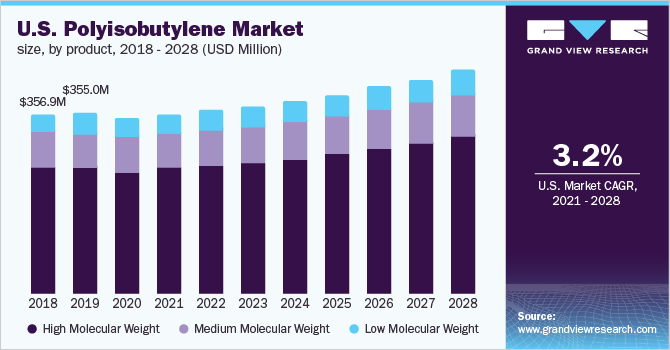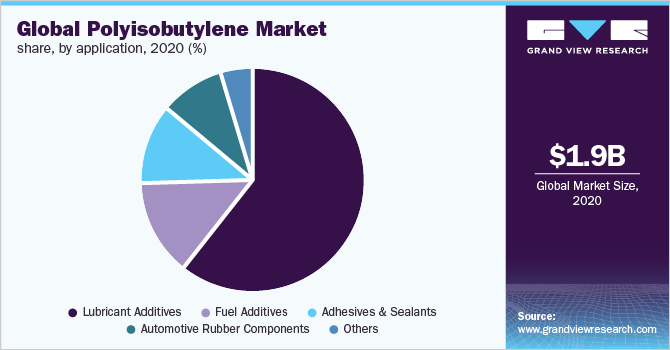- Home
- »
- Plastics, Polymers & Resins
- »
-
Global Polyisobutylene Market Size Report, 2021-2028GVR Report cover
![Polyisobutylene Market Size, Share & Trends Report]()
Polyisobutylene Market Size, Share & Trends Analysis Report By Product (High Molecular Weight, Medium Molecular Weight, Low Molecular Weight), By Application, By Region, And Segment Forecasts, 2021 - 2028
- Report ID: GVR-1-68038-230-3
- Number of Report Pages: 77
- Format: PDF, Horizon Databook
- Historical Range: 2017 - 2019
- Forecast Period: 2021 - 2028
- Industry: Bulk Chemicals
Report Overview
The global polyisobutylene market size was valued at USD 1.87 billion in 2020 and is expected to expand at a compound annual growth rate (CAGR) of 4.0% from 2021 to 2028. The growth of the market can be attributed to the use of polyisobutylene in various applications like adhesives and sealants, rubber automotive components, fuel additives, and lubricant additives. The tubeless tires have gained popularity in the automotive industry due to easy replacement and less maintenance. Polyisobutylene acts as a barrier to oxygen, making it a suitable material for the inner liner in tubeless tires. Polyisobutylene (PIB) exhibits low moisture and gas permeability and excellent insulation for electric current.

The COVID-19 drove a shift to remote working and increased voice traffic, residential broadband, and mobile data. The telecom industry responded favorably due to optical fibers usage to provide internet connections to ensure a positive user experience. The growth of the telecommunication industry is expected to drive the demand for polyisobutylene as a cable insulation material in electrical and electronics applications.
Asia Pacific accounted for a significant revenue share in the market in 2020. This is driven by the high demand from key industries, including automotive, construction, cosmetics, and aerospace, in emerging economies such as China and India. The COVID-19 pandemic impacted the manufacturing industries across the globe, which negatively impacted the growth of polyisobutylene in some end-use sectors, like cosmetics, due to supply chain disruptions.
Sea freight has emerged as a significant mode of transport due to high load carrying capacity, lesser costs, and safe and secured transportation. Growing initiatives on enhancing port infrastructures, rising bilateral trade agreements between countries, technological advancements in the development of low emission container ships to reduce environmental impact on water bodies, and the increase in global supply chains are expected to drive the lubricant market for ships engines. Due to the factors mentioned above, the growing container shipping business is anticipated to fuel the growth of the lubricant additives application segment in the market.
Product Insights
High molecular weight polyisobutylene dominated the market and accounted for a revenue share of more than 65.0% in 2020. Polyisobutylene is segmented into high, medium, and low molecular weight based on the molecular weight range. High molecular weight polyisobutylene is a transparent solid rubber-like substance with ultra-high viscosity and molecular weight. The high molecular weight helps polyisobutylene to retain its high elasticity and resilient properties. Due to the above-mentioned properties, it is used in a wide range of applications, including stretch films, lubricants, and adhesives in the industrial, transportation, and food sectors.
Medium molecular weight polyisobutylene is used in adhesives for its tackiness and plasticizing properties. PIB blended with low-density polyethylene improves the tear resistance, low-temperature flexibility, and clinging property of the film. Medium molecular weight polyisobutylene is used for food and beverage packaging due to its hydrophobic stability, antibacterial performance, adhesive nature, and food safety status.
Application Insights
Lubricant additives dominated the market and accounted for a revenue share of more than 55.0% in 2020. Emerging market in Asia Pacific due to the increasing industrial production is anticipated to drive the demand for industrial oil products over the forecast period. The chemical and mining industries are projected to be among the largest consumers of industrial lubricants. This growing trend is expected to boost the demand for industrial lubricants in applications, such as hydraulics, industrial engines, centrifuges, compressors, and bearings.
The automobile industry is witnessing rising demand for passenger and commercial vehicles for private and public transportations due to the growing population migration towards urban areas. Moreover, the growing e-commerce and logistics industry globally is expected to drive the consumption of commercial vehicles. Polyisobutylene is used as additives in engine fuel to prevent soot, sludge, and other deposit precursors from forming deposits onto the engine parts. This trend is expected to strengthen the demand for lubricants, thereby supporting the growth of polyisobutylene as a lubricant additive over the forecast years.

Due to its non-conductive electrical properties, together with its hydrophobic nature, polyisobutylene is used as a filling compound for copper and fiber optic cables. It is used to flood the armored layers within the cord to prevent water access and space the conductors. The cable-filling compounds protect against potential dielectric problems and insulate the optical fibers and metal conductor wires in the event of a fault in the cable covering or joints.
Regional Insights
Asia Pacific dominated the market and accounted for a revenue share of more than 30.0% in 2020. The demand for polyisobutylene in Asia Pacific is primarily driven by the high demand from key industries, including automotive, construction, cosmetics, and aerospace, in emerging economies such as China and India. Major tire manufacturers in Asia Pacific are moving towards developing tubeless tires for easy replacement. In addition, the growing trend of shifting towards electric vehicles is expected to drive the demand for tubeless tires to reduce maintenance and drag. Increasing automotive production in Asia Pacific is expected to drive the automotive rubber components application segment in the market.
The growing construction activities in Europe, coupled with the suitable measures such as tax breaks, incentives, and subsidies undertaken by several governments, are expected to boost the growth of the construction industry in the region. Polyisobutylene resins are used in sealant formulations and exhibit excellent chemical resistance to chemicals. Additionally, good aging characteristics, low out-gassing tendency, and moisture resistance make polyisobutylene suitable as hot melt sealants in double glazed windows. The growing investment in the construction industry is expected to increase the demand for polyisobutylene in adhesive applications.
Recovering the building and construction industry in Central and South America is expected to fuel the demand for polyisobutylene in applications, including manufacturing of adhesives and sealants and asphalt modifiers, used in various construction activities. The COVID-19 pandemic has compelled boost the construction industry to establish hospitals on a priority basis in North America. Moreover, national policies promoting the housing sector's recovery are expected to positively impact future construction trends. The construction sector's growth is anticipated to boost the adhesives and sealants application segment growth in the market.
Key Companies & Market Share Insights
The market has been characterized by the presence of key players, along with a few medium and small regional players. Established players such as BASF SE are launching their polyisobutylene products in new regions to strengthen their market position. For instance, in February 2021, BASF SE launched its polyisobutylene product under the brand name OPPANOL C in the North American market. OPPANOL C is produced as one-inch chips to reduce product development time and minimize manufacturing steps for customers by facilitating simpler and faster processing. Some prominent players in the global polyisobutylene market include:
-
BASF SE
-
Daelim Co., Ltd.
-
TPC Group
-
INEOS
-
Kothari Petrochemicals
-
Braskem
-
ENEOS Corporation
-
Zhejiang Shunda New Material Co., Ltd.
-
Shandong Hongrui New Material Technology Co., Ltd.
Polyisobutylene Market Report Scope
Report Attribute
Details
Market size value in 2021
USD 1.92 billion
Revenue forecast in 2028
USD 2.53 billion
Growth Rate
CAGR of 4.0% from 2021 to 2028
Base year for estimation
2020
Historical data
2017 - 2019
Forecast period
2021 - 2028
Quantitative units
Volume in tons, revenue in USD million, and CAGR (%) from 2021 to 2028
Report coverage
Volume forecast, revenue forecast, company profiles, competitive landscape, growth factors, and trends
Segments covered
Product, application, region
Regional scope
North America; Europe; Asia Pacific; Central & South America; Middle East& Africa
Country scope
U.S.; Canada; Mexico; Italy; France; China; India; Brazil
Key companies profiled
BASF SE; Daelim Co., Ltd.; TPC Group; INEOS; Kothari Petrochemicals; Braskem; ENEOS Corporation; Zhejiang Shunda New Material Co., Ltd.; Shandong Hongrui New Material Technology Co., Ltd.
Customization scope
Free report customization (equivalent up to 8 analysts’ working days) with purchase. Addition or alteration to country, regional, and segment scope.
Pricing and purchase options
Avail customized purchase options to meet your exact research needs. Explore purchase options
Segments Covered in the ReportThis report forecasts revenue and volume growth at the global, regional, and country levels and provides an analysis of the latest industry trends and opportunities in each of the sub-segments from 2017 to 2028. For this study, Grand View Research has segmented the global polyisobutylene market report based on product, application, and region:
-
Product Outlook (Volume, Tons; Revenue, USD Million, 2017 - 2028)
-
High Molecular Weight
-
Medium Molecular Weight
-
Low Molecular Weight
-
-
Application Outlook (Volume, Tons; Revenue, USD Million, 2017 - 2028)
-
Adhesives & Sealants
-
Automotive Rubber Components
-
Fuel Additives
-
Lubricant Additives
-
Others
-
-
Region Outlook (Volume, Tons; Revenue, USD Million, 2017 - 2028)
-
North America
-
U.S.
-
Canada
-
Mexico
-
-
Europe
-
Italy
-
France
-
-
Asia Pacific
-
China
-
India
-
-
Central & South America
-
Brazil
-
-
Middle East & Africa
-
Frequently Asked Questions About This Report
b. The global polyisobutylene market size was estimated at USD 1.87 billion in 2020 and is expected to reach USD 1.92 billion in 2021.
b. The polyisobutylene market is expected to grow at a compound annual growth rate of 4.0% from 2021 to 2028 to reach USD 2.53 billion by 2028.
b. The high molecular weight polyisobutylene in the product segment dominated the polyisobutylene market with a share of 67.78% in 2020. This is attributable to its high elasticity and resilient properties making it suitable to be used in a wide range of applications, including stretch films, lubricants, and adhesives in the industrial, transportation, and food sector.
b. Some key players operating in the polyisobutylene market include BASF SE; Daelim Co., Ltd.; TPC Group; INEOS; Kothari Petrochemicals; Braskem; ENEOS Corporation; Zhejiang Shunda New Material Co., Ltd.; and Shandong Hongrui New Material Technology Co., Ltd.
b. Key factors that are driving the polyisobutylene market growth include the increasing demand for tubeless tires in automotive industry and the rising demand for lubricant additives.
Share this report with your colleague or friend.
![gvr icn]()
NEED A CUSTOM REPORT?
We can customize every report - free of charge - including purchasing stand-alone sections or country-level reports, as well as offer affordable discounts for start-ups & universities. Contact us now
![Certified Icon]()
We are GDPR and CCPA compliant! Your transaction & personal information is safe and secure. For more details, please read our privacy policy.
We are committed towards customer satisfaction, and quality service.
"The quality of research they have done for us has been excellent."





